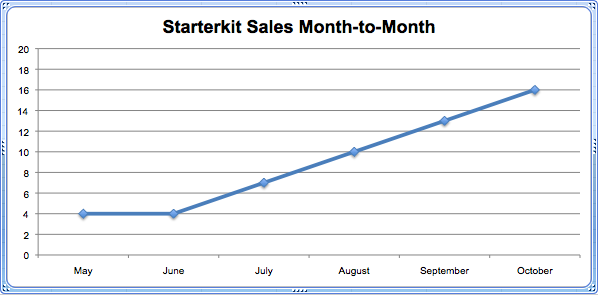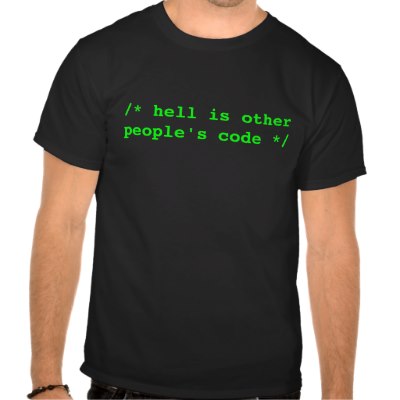This is just a quick report that my recent efforts on Kobold2D and on other fronts seem to be paying off. I looked at the sales of my Line-Drawing Starterkit over the past couple months, and I noticed a pleasant trend:

Many thanks to all supporters and customers!
This trend is particularly encouraging because I haven’t been doing any specific, targeted marketing or advertising for the Starterkit (as you might infer from the particularly low number of sales in May & June). I did however add it to binpress in August, and they apparently did some marketing (Google Adwords, Blog/Forum comments) but so far I’ve only sold two copies through binpress.
The number of sales for October is a projection. There were 10 sales this month, and since today is “October half-time” (15th) I pessimistically projected 16 sales. Also it made the trend line look real smooth and linear. 
New Product
It’s still not enough to earn a living, ie 10 sales amount to approximately $900 with all fees deducted, except tax. But I’m working on a new product to make ends meet. Something in the $49 area, something that will work for Cocos2D and Kobold2D Developers alike.
That something has something everything to do with multiplayer game programming. I think synchronizing the game state across multiple devices should be as simple as saying:
I’d like this property to be sent to all connected devices when it changes, thank you.
That’s all you should need to do to get data synched. Assuming an already established multiplayer connection. For that there’ll be an updated version of the GameKitHelper class, too.
| Follow @gaminghorror | Follow @kobold2d |
|












Hi,
I think low cost items which people will buy on impulse is a good business model, think App Store and Unity Asset store. Low cost, high volume. For example, a steering behaviour, or a homing missile, a fixed time step implemention, or A* path finding class…For me the line drawing kit is too focussed….but I would likely impulse buy everything I have mentioned at some point…look at the price point and features of something like LevelHelper….
Keep up the good work.
I
This is a common misconception. “Low price, many sales” only works out if there is a large number of potential customers, ie App Store -> $.99 apps with > $100,000 revenue.
The market for developers is a lot smaller, and they value products more highly, and differently. Source code that sells for < $10 to me looks like terrible value for my money - the thought goes like this: if it only costs that little, it's not going to save me much time, so I could as well implement it myself and probably better. I've seen a number of "Indie" stores with source code products priced that low. Almost all products that sold for < $10 looked cheap, if not ridiculous to even ask money for it. The product solved maybe just one problem, and not particularly well judging just from the description. Nobody wants to work with "cheap code". Developers have a hard time even coming to terms with that occasionally you'll have to work with other people's code. 😀
I think pricing for source code products should be at least $20 for the low-end products, that might be something simple like a virtual joypad implementation (SneakyInput). Below that value it doesn’t make much sense to buy source code, because the chances that it’s either low quality or not covering enough use cases is pretty high - if only perceived.
I bought the line-drawing kit quite a few months back, and it has been fantastic. While you could take the product, fiddle with it a bit and use it as a shortcut to a great result I’ve realised value from it in an entirely different way.
I found the more of my own time I invested in it the more and more value I’ve gotten out of it. I’ve completely deconstructed, and reconstructed the project - starting from scratch and working elements of it into my own projects, modifying where need be.
While on the surface it is a wonderful ‘Line Drawing’ kit, if you are willing to invest the hours it is nothing short of a master class in iOS game design.
For example, the whole singleton pattern used throughout initially frustrated and confused me if I tried to extend it too much, but after working through why and where it is appropriate it has been a game changer for me. Just last night I dropped in a self contained HUD from a ‘Line-Drawing’ project into a new ‘not Line-Drawing’ project, typed four lines of code and hey presto - it just worked.
Would I get this level of understanding from a bunch of great but loosely related tutorials? I think no. Would I have put so much effort into understanding and learning from the Line Drawing kit if I paid $10 on a whim for it? Again, I just don’t think so. I like this model.
Steffen, have you ever considered breaking something like the Line Drawing Kit into a subscription model? Something along the lines of starting from scratch on a largish (say 12 week) project, breaking it into regular weekly/fortnightly/monthly drops with a screencast?
Subscribers pay $30-$40 a month, then at the end you publish the game with all the subscribers names in the credits (a little ‘early adopter’ bonus), and then offer the full kit for everyone else to purchase?
This may help bring forward some cash-flow (as you are sooner to market), giving some of your dedicated fans a chance to give you cash while you are working to completion. Perhaps it will also tempt someone who is on the fence about trying a premium tutorial without a major up front purchase. If they aren’t into it they can drop out.
Once you are a game or two in, for the stuff that is the same in every project (gamecenter etc) you could swap it out for other topics, like website integration, porting to different environments, or integrating new iOS technologies in a gaming project context.
Keep up the great work!
Thanks, I’m happy to hear you got so much out of the Starterkit!
I have considered a subscription model in the past and still do. It is a tempting idea because subscription means a relatively constant base income I could depend on. But I would have also create enough content every month to make it worth the money. The biggest part I don’t like about it is that it would create a closed community, and I would start regarding community members as a two-class community: those who pay, and those who don’t.
For that reason I’ll prefer selling individual products, but limit the upgrade & support time to 6 or 12 months. If you want to continue receiving upgrades after that time, you would pay a smaller amount (ie 50% of current full price) to continue receiving updates. It is sort of like an “opt-in” subscription deal. It would also tell me how long-lasting the product is, and whether it is good as it is (people rarely upgrade because they’ve used and understood the product) or benefits from frequent updates. And the community remains on the same level, and the best advertisement I can do is to offer free help, guides, tutorials and code.
It’s October 27th. My projection of 16 sales this month was correct. It can only get better in the remaining 3 days.